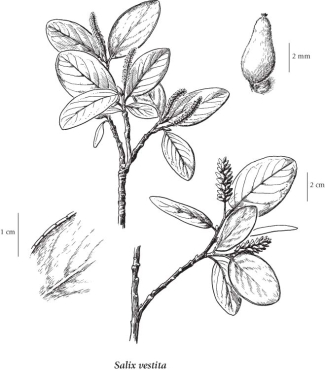Salix vestita Pursh
rock willow
Salicaceae (Willow family)
Introduction to Vascular Plants
rock willow
Salicaceae (Willow family)
Introduction to Vascular Plants
Species Information click to expand contents
General:
Dioecious shrubs, 0.2-1.5 m tall, not colonial; branches erect, flexible at base; twigs yellow- to grey-brown, sparsely to densely hairy.
Leaves:
Alternate, simple, leathery, broadly elliptic to egg-shaped, 2-7 cm long, 1-4 cm wide, lower surface glaucous, long soft-hairy or veins with long straight hairs, hairs white, upper surface shiny, deeply impressed veiny, smooth or silky, margins entire or toothed, bases rounded, tips rounded or notched; leaf stalks with or without dark, glandular dots at top; stipules rudimentary.
Flowers:
Unisexual, lacking sepals and petals, borne in catkins which flower as leaves emerge, the catkins slender, on leafy twigs; floral bracts pale, hairs straight; stamens 2; ovaries 1, hairy; styles 0.2-0.4 mm long.
Fruits:
Capsules which split open to release the seeds, each of which is surrounded by a tuft of hairs; stalks 0.4-1.2 mm long.
Notes:
In this species the vegetative twigs almost always terminate in a catkin.
Illustration click to expand contents

If more than one illustration is available for a species (e.g., separate illustrations were provided for two subspecies) then links to the separate images will be provided below. Note that individual subspecies or varietal illustrations are not always available.
Illustration Source: The Illustrated Flora of British Columbia
Ecology click to expand contents
Ecological Framework for Salix vestita
The table below shows the species-specific information calculated from
original data (BEC database) provided by the BC Ministry of Forests and Range.
(Updated August, 2013)
The table below shows the species-specific information calculated from
original data (BEC database) provided by the BC Ministry of Forests and Range.
(Updated August, 2013)
| Site Information |
Value / Class |
||
|
Avg |
Min |
Max |
|
| Elevation
(metres) |
1863 | 97 | 2550 |
| Slope
Gradient (%) |
31 | 0 | 99 |
|
Aspect (degrees) |
6 | 0 | 360 |
| Soil
Moisture Regime (SMR) [0 - very xeric; 4 - mesic; 8 - hydric] |
3 | 0 | 8 |
| Modal
Nutrient Regime
Class |
C | ||
| #
of field plots species was recorded in: |
132 | ||
| Modal
BEC Zone Class |
ESSF | ||
|
All BEC Zones (# of stations/zone) species was recorded in |
AT(4), BAFA(1), BWBS(2), ESSF(65), ICH(4), IMA(1), MS(2), SWB(5) | ||
|
Source:
Klinkenberg 2013
|
|||
Habitat and Range click to expand contents
Moist to dry open forests and rocky streamsides in the upper montane and subalpine zones, rarely in the alpine zone; locally common in extreme E BC, less common westward; E to AB and disjunct in N MB to NS and NF and S to MT and OR.
Status Information click to expand contents
Synonyms click to expand contents
Synonyms and Alternate Names:
Salix fernaldii Blank.
Salix leiolepis Fernald
Salix reticulata var. vestita (Pursh) Andersson
Salix vestita subsp. leiolepis (Fernald) Argus
Salix vestita var. erecta Andersson
Salix vestita var. humilior Andersson
Salix vestita var. psilophylla Fernald & H. St. John